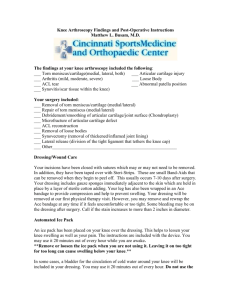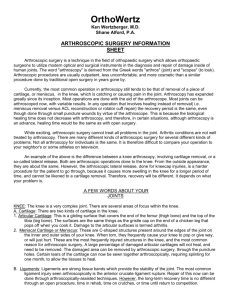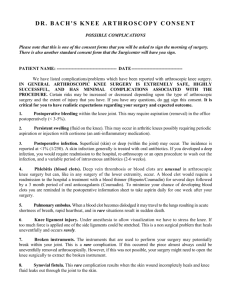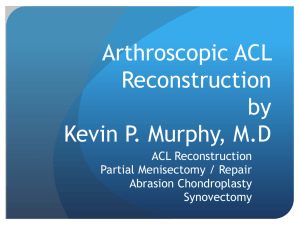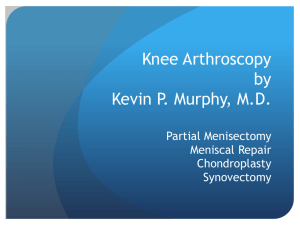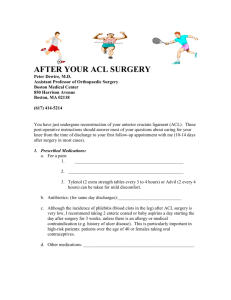Post-Operative guide for ACL Reconstruction with Allograft
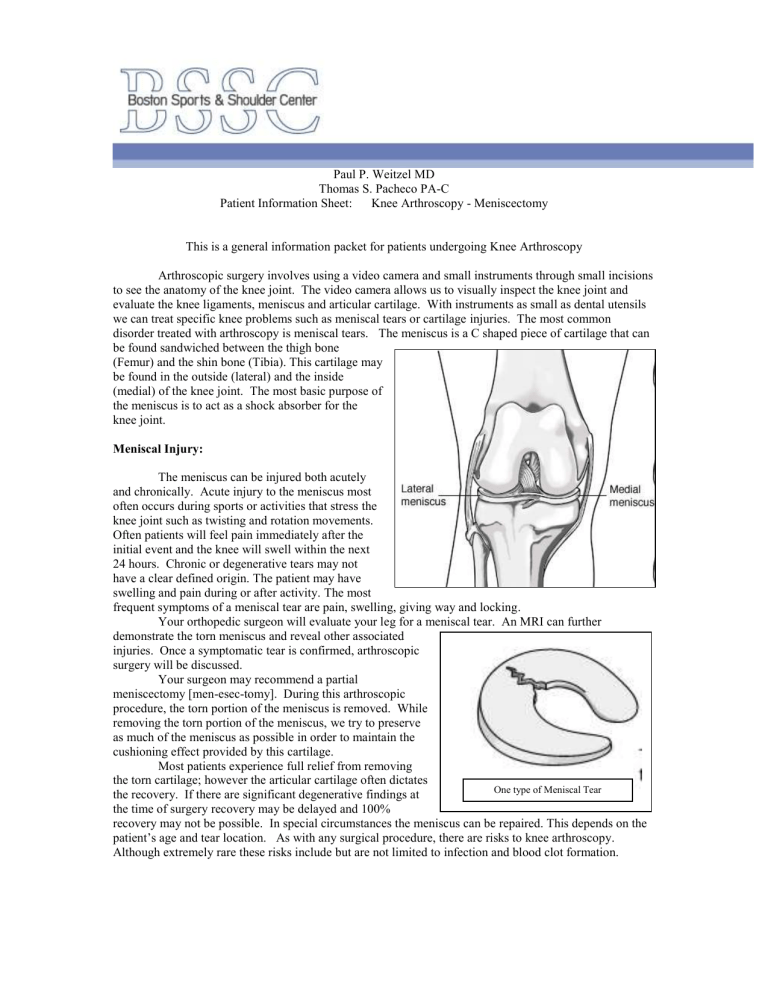
Paul P. Weitzel MD
Thomas S. Pacheco PA-C
Patient Information Sheet: Knee Arthroscopy - Meniscectomy
This is a general information packet for patients undergoing Knee Arthroscopy
Arthroscopic surgery involves using a video camera and small instruments through small incisions to see the anatomy of the knee joint. The video camera allows us to visually inspect the knee joint and evaluate the knee ligaments, meniscus and articular cartilage. With instruments as small as dental utensils we can treat specific knee problems such as meniscal tears or cartilage injuries. The most common disorder treated with arthroscopy is meniscal tears.
The meniscus is a C shaped piece of cartilage that can be found sandwiched between the thigh bone
(Femur) and the shin bone (Tibia). This cartilage may be found in the outside (lateral) and the inside
(medial) of the knee joint. The most basic purpose of the meniscus is to act as a shock absorber for the knee joint.
Meniscal Injury:
The meniscus can be injured both acutely and chronically. Acute injury to the meniscus most often occurs during sports or activities that stress the knee joint such as twisting and rotation movements.
Often patients will feel pain immediately after the initial event and the knee will swell within the next
24 hours. Chronic or degenerative tears may not have a clear defined origin. The patient may have swelling and pain during or after activity. The most frequent symptoms of a meniscal tear are pain, swelling, giving way and locking.
Your orthopedic surgeon will evaluate your leg for a meniscal tear. An MRI can further demonstrate the torn meniscus and reveal other associated injuries. Once a symptomatic tear is confirmed, arthroscopic surgery will be discussed.
Your surgeon may recommend a partial meniscectomy [men-esec-tomy]. During this arthroscopic procedure, the torn portion of the meniscus is removed. While removing the torn portion of the meniscus, we try to preserve as much of the meniscus as possible in order to maintain the cushioning effect provided by this cartilage.
Most patients experience full relief from removing the torn cartilage; however the articular cartilage often dictates the recovery. If there are significant degenerative findings at the time of surgery recovery may be delayed and 100%
One type of Meniscal Tear recovery may not be possible. In special circumstances the meniscus can be repaired. This depends on the patient’s age and tear location. As with any surgical procedure, there are risks to knee arthroscopy.
Although extremely rare these risks include but are not limited to infection and blood clot formation.
Pre-Surgery:
Before surgery, patients are instructed to continue to be as active as the knee permits excluding participation in sports . The following are specific instructions leading up to arthroscopic knee surgery.
On the night before surgery, do not eat after midnight (no chewing gum or lozenges).
On the morning of surgery you may take your daily pills with a sip of water.
Your surgery time will be confirmed the day before the surgery by Dr. Weitzel’s office.
The original time may be adjusted based on patient needs and equipment availability
Patients should bring their MRI and X-rays to the surgery.
If your surgery is done at our Waltham facility, the person who is accompanying you is welcome to a free one-day gym pass.
Surgery:
The length of the procedure is approximately 20-45 minutes. This may be longer depending on whether there are other associated injuries. Your nurse will bring you into the pre-op area were you will have an IV placed and met with your anesthesiologist. General anesthesia is utilized to assure a comfortable surgery. Most patients will have a small tube placed in their windpipe; formal intubation may not be required. This means that you will be “asleep” and completely unaware of the surgery until you wake up in the recovery area. The procedure is also available to view online at www.bostonssc.com.
Post-Surgery:
After the surgery is completed, you will awaken in the operating room and be moved to the recovery area. After surgery, most patients generally recover smoothly and have minimal pain due to local pain medication that is used at the completion of the surgery.
A pain medication prescription will be provided prior to discharge. You may take the prescribed medication as directed. You should expect to experience moderate knee discomfort for several days and even weeks following the surgery. Patients often only need prescription narcotics for a few days following the surgery and then switch to over-the-counter medications such as Tylenol or Ibuprofen.
Ice bags and elevation should be utilized to decrease swelling and pain. Ice should be applied to the knee up to three times a day for 20 minutes until swelling subsides
Special cooling devices (called Cryo/Cuffs) are also available for patients to purchase thru our office. This can be used in the place of the ice bags. See the included information sheets if you would like to purchase one of these cooling devices.
You should be comfortable walking independently with crutches before leaving the hospital or surgery center. You will be able to put as much weight as tolerated on your leg.
If the bandage is draining, reinforce it with additional dressings for the first 24 hours. After 24 hours, remove the bandage and place band aids over the incision sites. Showering is acceptable at this time. Do not submerge or scrub the knee.
Rehabilitation starts the day of surgery. See exercises at end of packet Set aside 3-4 times a day for range of motion and exercise strengthening program. Make an appointment to start physical therapy during post-operative week .
Take one 325 mg (full strength) aspirin daily for 21 days (unless otherwise instructed or allergic) to prevent blood clots.
Follow up with Dr. Weitzel or Thomas Pacheco PA-C within 2 weeks from the date of surgery
Eat a regular diet as tolerated and please drink plenty of fluids.
First post-op appointment is 7-10 days for suture removal
You may drive once you establish control of you operative extremity. If your right knee was operated on, this may take approximately 3-5 days to achieve
Call office for Temperature >102 degrees, excessive swelling, pain or redness around incisions.
Plan at least 2-3 days away from work or school. Utilize this time to decrease swelling and participate in your home exercise program. You may be able to resume work once the pain and
swelling resolves (this varies based on job activity).
Meniscal Repair:
If your meniscus was repaired during the surgery, your rehabilitation will be slightly altered:
1) Maintain non-weight bearing on your leg until first post operative visit.
2) Brace instructions: Typically used for 4 weeks. This will be discussed further at first post-operative visit.
Arthroscopic view of a Meniscal Repair
Post-op Rehabilitation Protocol – Partial Meniscectomy
Phase 1 (Week 0-1):
Goals: Minimize effusion, Full range of motion, Initiate isotonic CKC exercises, Normalize gait pattern/balance and proprioception abilities.
Treatment plan:
1) Swelling Control with ice and compression wrap
2) Progress towards full range of motion
3) Initiate quadriceps and hamstring muscle activation and general leg control
Quad setting, SLR, heel slides, isometric hamstring/quadriceps contraction
Ankle pumps
4) WBAT with crutches
5) Electrical stimulation to quadriceps muscle
Phase 2 (Weeks 1-3):
Goals: Progress quadriceps/hamstring strengthening, independent mobility
Treatment plan :
1) Independent ambulation
2) Continue with swelling control
3) Progress strengthening
4) Balance and Proprioception: Single leg stance/weight shifting
Phase 3 (Weeks 3-5):
Goals: Full lower extremity strengthening/conditioning program, Full activity in gym
Treatment plan:
1) Progress CKC strengthening – lunges/ reverse lunges/ single leg squats
2) Full ROM – Full revolution on bike
3) Progress dynamic balance training
4) Sports specific strengthening and conditioning
Early Post-operative Exercises
Start the following exercises as soon as you are able. You can begin these in the recovery room shortly after surgery. You may feel uncomfortable at first, but these exercises will speed your recovery and actually diminish your post-operative pain.
Quad Sets - Tighten your thigh muscle. Try to straighten your knee. Hold for 5 to 10 seconds. Repeat this exercise approximately 10 times during a two minute period, rest one minute and repeat.
Straight Leg Raises - Tighten the thigh muscle with your knee fully straightened on the bed, as with the Quad set. Lift your leg several inches. Hold for five to 10 seconds. Slowly lower. Repeat until your thigh feels fatigued.
Ankle Pumps - Move your foot up and down rhythmically by contracting the calf and shin muscles. Perform this exercise periodically for two to three minutes, two or three times an hour in the recovery room. Continue this exercise until you are fully recovered and all ankle and lower-leg swelling has subsided.
Knee Straightening Exercises - Place a small rolled towel just above your heel so that it is not touching the bed. Tighten your thigh.
Try to fully straighten your knee and to touch the back of your knee to the bed.
Hold fully straightened for five to 10 seconds. Repeat until your thigh feels fatigued.
Bed-Supported Knee Bends - Bend your knee as much as possible while sliding your foot on the bed. Hold your knee in a maximally bent position for 5 to 10 seconds and then straighten. Repeat several times until your leg feels fatigued or until you can completely bend your knee.
